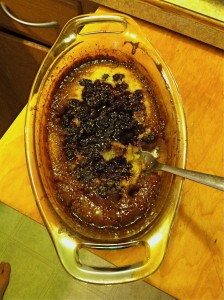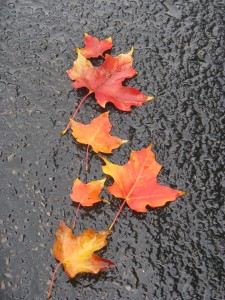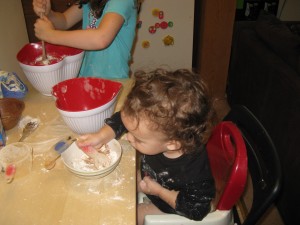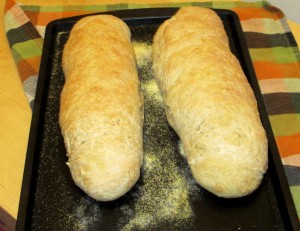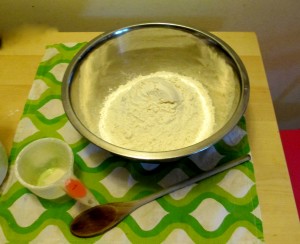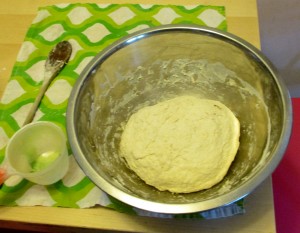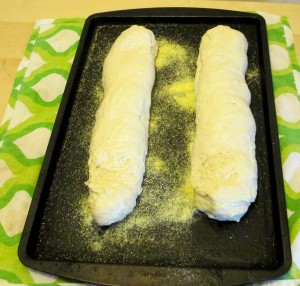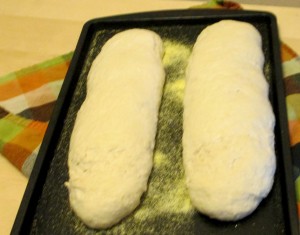By Brenda Winter Hansen
I confess, around my house, if you bust out the M word (M-A-T-H), there will be groans. Luckily, skill-building results have been achieved without even uttering that four-letter word. Most of us eat three meals plus snacks every day, so even for the most recalcitrant kid, it’s easy to weave some hands-on number play into the day without them blinking. It’s the repetition of the basics of math that builds a strong foundation for the understanding of more sophisticated concepts.
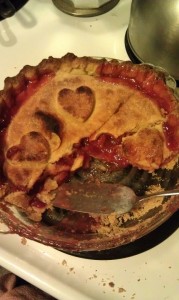 My personal favorite kitchen math experience is baking, pie (Pi!) in particular. Pie has the double whammy effect of using fractions for the measuring that goes into making pie, as well as the resulting edible “pie chart.” Addition, subtraction, “plutification,” and division, naturally follow. Simply irresistible! Obviously, just about anything you bake can go into a round pan, but square and rectangle pans offer up a necessary visual contrast to standard circles. Don’t be shy about introducing fractions to pre-schoolers, just keep them part of the cooking conversation until they are teenagers.
My personal favorite kitchen math experience is baking, pie (Pi!) in particular. Pie has the double whammy effect of using fractions for the measuring that goes into making pie, as well as the resulting edible “pie chart.” Addition, subtraction, “plutification,” and division, naturally follow. Simply irresistible! Obviously, just about anything you bake can go into a round pan, but square and rectangle pans offer up a necessary visual contrast to standard circles. Don’t be shy about introducing fractions to pre-schoolers, just keep them part of the cooking conversation until they are teenagers.
TIP: Keep the tone light and fun. Your child will learn more about math, and baking, if you can keep it fun.
WARNING—Be prepared for some mess. Build clean-up into the waiting-while-it’s-baking, but don’t worry about it too much until then. Discuss your kitchen rules. Here’s a simple starting point.
If your child is totally new to cooking, help them become familiar with measuring. Have at least one complete set of measuring spoons on hand, and both liquid and dry measuring cups.
Bonus: Get your kid their own equipment! Thrift or discount stores are perfect for inexpensive kitchen gear. They will be thrilled to experiment on their own and help you out later.
Spend some time demonstrating how one fourth of a cup fits four times into a full cup and then reverse the process: show how one cup fills a quarter cup four times. A handy conversion/measurement equivalency chart (laminated would be great!) will help you and an older child become familiar with volume and how spoons and cups fit together. This is also a good moment to let your child practice measuring flour and see what happens when they over or under fill three one-third cups if the goal is to end up with one.
Once you have the ingredients assembled for your favorite baking recipe and have pre-read the recipe (if able, let your child read it out loud), be as hands-off as possible. Lead with questions to keep your child’s brain and hands simultaneously engaged. It’s an effective way for the experience to stick in their hungry brains. For example: If the recipe calls for three cups of flour, and we want to use half whole wheat, how many half-cups of white flour do we need? Or simply: How many half-cups in three cups? This kind of question is easy to tailor to your child’s age and development.
After the fun of measuring, mixing, baking, and cleaning up a bit, you get to reap the rewards! My daughter (10) claims to hate math but loves fractions, “especially the cutting pie part!” Most children are visual learners first and slicing up pie is a natural way to see math happen. Make it a game. Start by cutting the pie in half. Discuss the words “whole” and “half” in the context of your child eating that much. Do you want the whole pie or will you share half of it with me? Now slice one of the halves in half. Add “fourth” and “quarter” to the conversation. If your child is already money conscious (or getting there) bring in four quarters and a dollar and raise the level of discussion to value, not just volume.
Finally, bring in situational elements. How many people are in your household or coming for dinner? If everyone is willing, you can actually make this a dessert discussion, but you’ll have to convince everybody to wait to eat their pie. Cut the pie in eighths, give three people one slice, another person gets two slices, and the last person gets five. How many eighths does each person have? What if so-and-so had to leave early or a neighbor showed up for a visit? Is there enough pie? Let it get silly and come up with your own questions and stories. Making a narrative with fractions will reinforce the usefulness and practicality of math in everyday life…and turn story problems into fraction fun!

